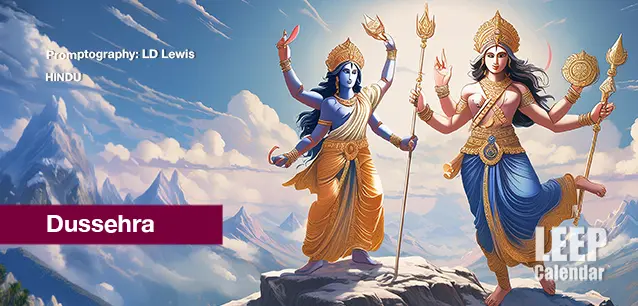 AD
AD
Today is: December 26
Scroll to explore events active on this date.
LEEP INK FEATURES

2025 is the Year of...
21 Themes and 'Year of' Events for 2025 PART ONE, THE FIRST 12 Every year, various organizations announce the theme for the year. These themes can focus on causes, such as aesthetics and color tre...

Nuanced November 2024
November is the start of the holiday season in many parts of the world. It is a time for family, football, food, shopping and decorating, particularly in the Christian and Jewish world, leading to Christmas and...

December's Gift
Events in December 2024. Well, we made it to December. December is the holiday season, particularly in Western nations, where Christianity and Judaism are the faiths most common in the nation's past. ...
About the Hindu Day of Dussehra (Vijaya Dashmi)
Festivals & Fairs , India
Ends: Oct 02, 2025
DESCRIPTION:
DUSSEHRA:
CELEBRATING THE TRIUMPH OF GOOD OVER EVIL
Dussehra, also known as Vijayadashami, is a major Hindu festival that celebrates the victory of good over evil. The festival marks Lord Rama's defeat of the demon king Ravana, as told in the ancient Indian epic, the Ramayana. It also honors Goddess Durga's triumph over the buffalo demon Mahishasura, symbolizing the destruction of evil and the restoration of righteousness. This victory serves as an inspiring reminder that no matter how powerful evil may seem, goodness and righteousness always prevail.
NAVARATRI
The holiday is significant because it represents the eternal struggle between good and evil, reminding us that virtue ultimately prevails. It typically falls in September or October, concluding the nine-day festival of Navaratri.
Navaratri is a significant Hindu festival that spans nine nights and ten days. It is dedicated to the worship of the Goddess Durga and her nine forms, collectively known as Navadurga. The word "Navaratri" translates to "nine nights" in Sanskrit, and during this period, devotees honor the divine feminine energy or Shakti. The festival typically occurs in the autumn, either in September or October and culminates with Dussehra, marking the victory of good over evil.
DUSSEHRA'S ROLE IN NAVARATRI
Dussehra's importance spans India, with different regions observing distinct traditions reflecting their local culture and history.
The origins of Dussehra date back thousands of years, rooted in both the Ramayana and various legends tied to Durga. Celebrations differ across India, each with its unique customs and traditions. In the north, dramatic reenactments of the Ramayana, known as Ramlila, are performed, culminating in the burning of giant effigies of Ravana, his brother Kumbhakarna, and his son Meghnad, symbolizing their destruction. In the east, particularly in Bengal, the day is marked by Durga Puja, where elaborate idols of the goddess Durga are immersed in rivers or seas, accompanied by music and dance.
Customs during Dussehra include processions, cultural performances, and fairs. People also worship tools, vehicles, and weapons, a tradition known as "Ayudha Puja," to seek blessings for future success. The holiday encourages reflection on the virtues of honesty, courage, and perseverance while fostering a sense of community through collective celebration.
VIDEOS
Currently, this event does not have supporting videos.
SUPPORTING DOCUMENTS
Currently, this event does not have supporting documents.
ADDITIONAL IMAGES
Currently, this event does not have supporting images.
Where would you like to go now?
 AD
AD


/footer-logo.svg)
